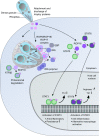Toxoplasma Effectors Targeting Host Signaling and Transcription
- PMID: 28404792
- PMCID: PMC5475222
- DOI: 10.1128/CMR.00005-17
Toxoplasma Effectors Targeting Host Signaling and Transcription
Abstract
Early electron microscopy studies revealed the elaborate cellular features that define the unique adaptations of apicomplexan parasites. Among these were bulbous rhoptry (ROP) organelles and small, dense granules (GRAs), both of which are secreted during invasion of host cells. These early morphological studies were followed by the exploration of the cellular contents of these secretory organelles, revealing them to be comprised of highly divergent protein families with few conserved domains or predicted functions. In parallel, studies on host-pathogen interactions identified many host signaling pathways that were mysteriously altered by infection. It was only with the advent of forward and reverse genetic strategies that the connections between individual parasite effectors and the specific host pathways that they targeted finally became clear. The current repertoire of parasite effectors includes ROP kinases and pseudokinases that are secreted during invasion and that block host immune pathways. Similarly, many secretory GRA proteins alter host gene expression by activating host transcription factors, through modification of chromatin, or by inducing small noncoding RNAs. These effectors highlight novel mechanisms by which T. gondii has learned to harness host signaling to favor intracellular survival and will guide future studies designed to uncover the additional complexity of this intricate host-pathogen interaction.
Keywords: chromatin remodeling; epigenetics; immune evasion; innate immunity; intracellular pathogen; serine/threonine kinases; signal transduction; transcription factors.
Copyright © 2017 American Society for Microbiology.
Figures






Similar articles
-
Toxoplasma gondii manipulates host cell signaling pathways via its secreted effector molecules.Parasitol Int. 2021 Aug;83:102368. doi: 10.1016/j.parint.2021.102368. Epub 2021 Apr 24. Parasitol Int. 2021. PMID: 33905814 Review.
-
Hypermigration of macrophages through the concerted action of GRA effectors on NF-κB/p38 signaling and host chromatin accessibility potentiates Toxoplasma dissemination.mBio. 2024 Oct 16;15(10):e0214024. doi: 10.1128/mbio.02140-24. Epub 2024 Aug 29. mBio. 2024. PMID: 39207098 Free PMC article.
-
Differential Impacts on Host Transcription by ROP and GRA Effectors from the Intracellular Parasite Toxoplasma gondii.mBio. 2020 Jun 9;11(3):e00182-20. doi: 10.1128/mBio.00182-20. mBio. 2020. PMID: 32518180 Free PMC article.
-
Rhoptries are major players in Toxoplasma gondii invasion and host cell interaction.Cell Microbiol. 2007 Apr;9(4):841-8. doi: 10.1111/j.1462-5822.2007.00909.x. Epub 2007 Mar 8. Cell Microbiol. 2007. PMID: 17346309 Review.
-
The coccidian parasites Toxoplasma and Neospora dysregulate mammalian lipid droplet biogenesis.J Biol Chem. 2017 Jun 30;292(26):11009-11020. doi: 10.1074/jbc.M116.768176. Epub 2017 May 9. J Biol Chem. 2017. PMID: 28487365 Free PMC article.
Cited by
-
Inflammasome Activation Dampens Type I IFN Signaling to Strengthen Anti-Toxoplasma Immunity.mBio. 2022 Dec 20;13(6):e0236122. doi: 10.1128/mbio.02361-22. Epub 2022 Oct 10. mBio. 2022. PMID: 36214572 Free PMC article.
-
Dehydroepiandrosterone Effect on Toxoplasma gondii: Molecular Mechanisms Associated to Parasite Death.Microorganisms. 2021 Mar 2;9(3):513. doi: 10.3390/microorganisms9030513. Microorganisms. 2021. PMID: 33801356 Free PMC article.
-
Apical annuli are specialised sites of post-invasion secretion of dense granules in Toxoplasma.Elife. 2024 Jan 25;13:e94201. doi: 10.7554/eLife.94201. Elife. 2024. PMID: 38270431 Free PMC article.
-
Toxoplasma-host endoplasmic reticulum interaction: How T. gondii activates unfolded protein response and modulates immune response.Curr Res Microb Sci. 2024 Feb 1;6:100223. doi: 10.1016/j.crmicr.2024.100223. eCollection 2024. Curr Res Microb Sci. 2024. PMID: 38352129 Free PMC article. Review.
-
The Toxoplasma gondii effector GRA83 modulates the host's innate immune response to regulate parasite infection.mSphere. 2023 Oct 24;8(5):e0026323. doi: 10.1128/msphere.00263-23. Epub 2023 Sep 28. mSphere. 2023. PMID: 37768053 Free PMC article.
References
-
- Dubey JP. 2010. Toxoplasmosis of animals and humans. CRC Press, Boca Raton, FL.
-
- Levine ND. 1988. The protozoan phylum Apicomplexa, vol 1 and 2. CRC Press, Boca Raton, FL.
-
- Pawlowski J, Audic S, Adl S, Bass D, Belbahri L, Berney C, Bowser SS, Cepicka I, Decelle J, Dunthorn M, Fiore-Donno AM, Gile GH, Holzmann M, Jahn R, Jirku M, Keeling PJ, Kostka M, Kudryavtsev A, Lara E, Lukes J, Mann DG, Mitchell EA, Nitsche F, Romeralo M, Saunders GW, Simpson AG, Smirnov AV, Spouge JL, Stern RF, Stoeck T, Zimmermann J, Schindel D, de Vargas C. 2012. CBOL protist working group: barcoding eukaryotic richness beyond the animal, plant, and fungal kingdoms. PLoS Biol 10:e1001419. doi:10.1371/journal.pbio.1001419. - DOI - PMC - PubMed
Publication types
MeSH terms
Grants and funding
LinkOut - more resources
Full Text Sources
Other Literature Sources

